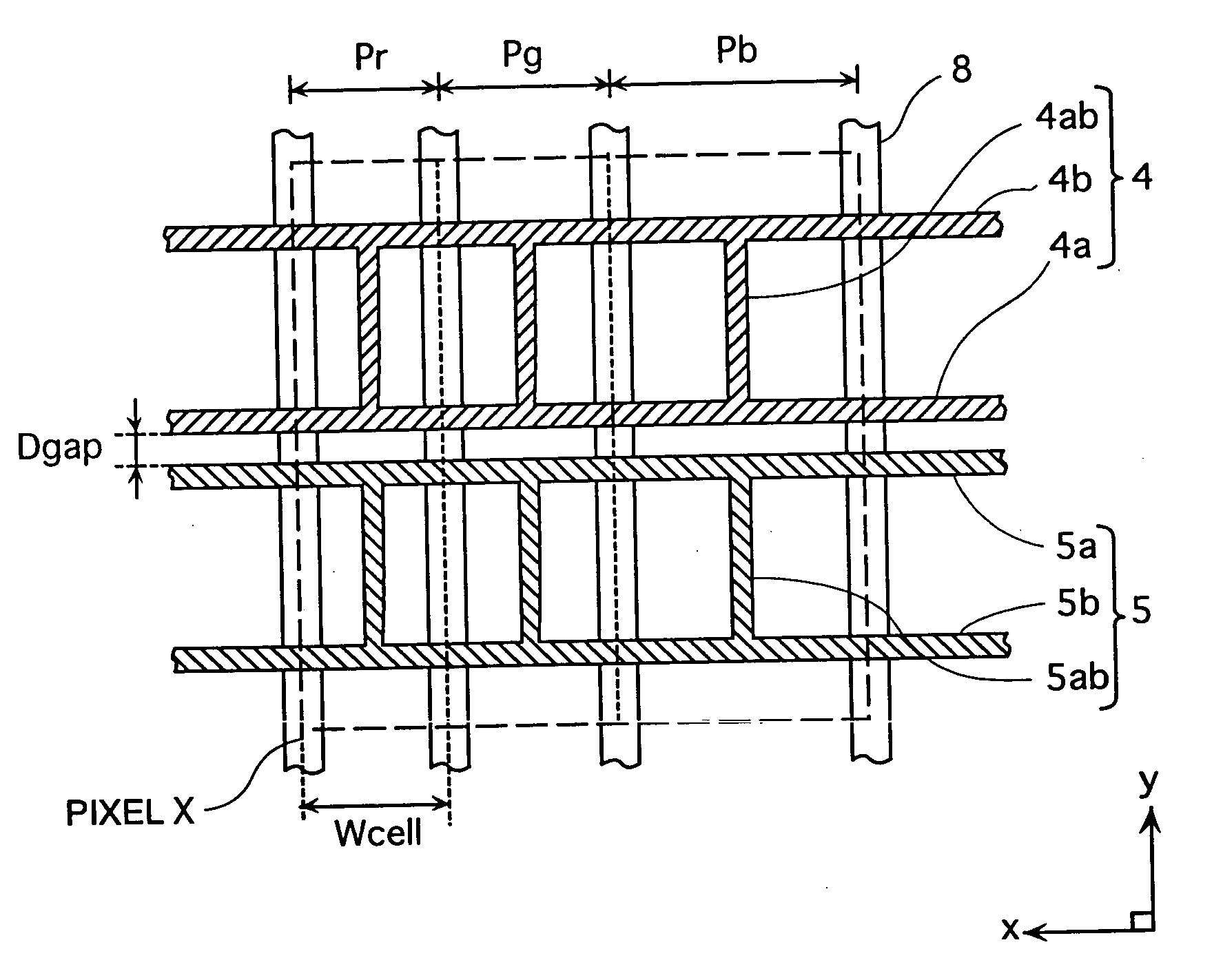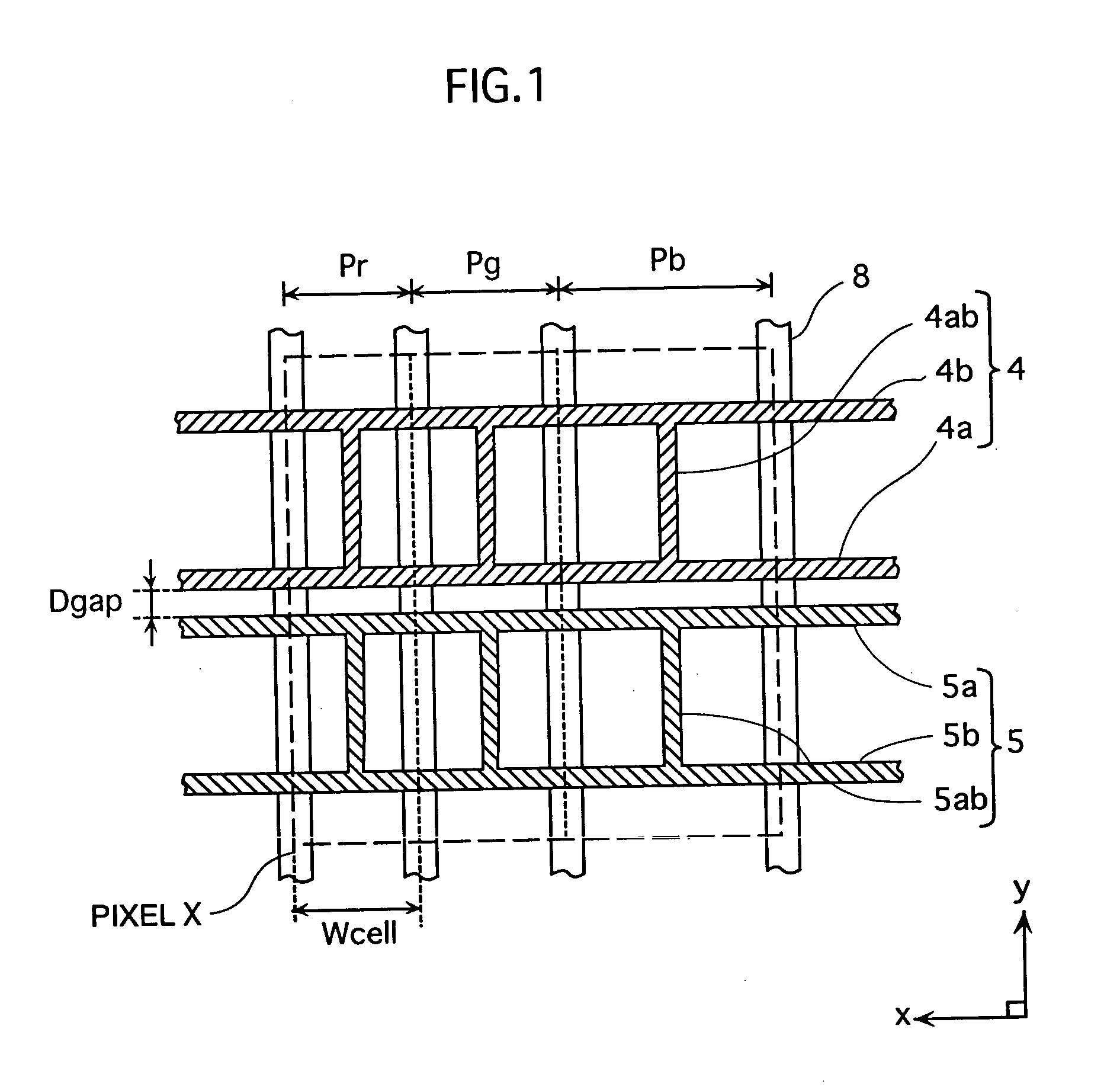Gas dischargeable panel
a dischargeable panel and gas technology, applied in the direction of instruments, static indicating devices, electrodes, etc., can solve the problems of increasing the need for pdps power consumption, increasing the need for pdps technology to achieve low power consumption, and difficult stable production, so as to achieve reduced power consumption, reduced loss of visible light, and improved reflectivity
- Summary
- Abstract
- Description
- Claims
- Application Information
AI Technical Summary
Benefits of technology
Problems solved by technology
Method used
Image
Examples
first embodiment
[0104] on the other hand, there is only one discharge current peak. Hence stable sustain discharge can be performed when compared with the case where a plurality of peaks occur. This enables the gray scale control by pulse modulation to be exercised with stability, with it being possible to ensure excellent display performance.
[0105] In the first embodiment, the discharge current waveform has a single peak. Accordingly, the discharge illumination waveform has a single peak, too.
[0106] In the first embodiment, the above display electrode pattern is applied to a construction where the cell width in the x direction differs for each color of red, green, and blue. By doing so, variations in discharge firing voltage among the three colors of red, green, and blue are eliminated. As a result, a stable image display can be produced.
[0107] FIG. 3A is a graph showing the correlation between the widths of the line parts 4a, 4b, 5a, and 5b and the panel luminance. The widths of the line parts 4...
second embodiment
[0157] (Second Embodiment)
[0158] 2-1. Structure of a Display Electrode
[0159] The second embodiment is fundamentally based on the first embodiment, but is characterized in that a display electrode is made up of three or more line parts 4a, 4b, . . . and connector parts 4ab, 4bc, . . . which are arranged in he y direction in a straight line to connect the line parts.
[0160] FIG. 10 shows an example of the display electrode structure of the second embodiment. In the drawing, the scan electrode 4 (sustain electrode 5) has three line parts 4a-4c (5a-5c) that are connected by connector parts 4ab and 4bc (5ab and 5bc) arranged in a straight line in the y direction. The distance Dab between the line parts 4a and 4b (5a and 5b) is equal to the distance Dbc between the line parts 4b and 4c (5b and 5c). It is preferable for Dab and Dbc to be larger than the main discharge gap Dgap, to increase the opening ratio. As a result, high luminance can be obtained, and the voltage can be further reduced...
third embodiment
[0201] (Third Embodiment)
[0202] 3-1. Structure of a Display Electrode
[0203] In the first and second embodiments, a display electrode is made up of at least two line parts and at least one connector part which electrically connects the line parts, when the red cell, the green cell, and the blue cell have different widths in the x direction.
[0204] In the third embodiment, the display electrode 4 (5) includes three line parts 4a-4c (5a-5c) and projection parts 4aq and 4bq (5aq and 5bq) which are each provided on one side of any of the line parts 4a and 4b (5a and 5b) as a discharge developing part, as shown in FIG. 17. Here, the projection parts 4aq and 4bq (5aq and 5bq) have a rectangular shape, and are formed so as to extend in the y direction.
[0205] These projection parts 4aq and 4ba (5aq and 5bq) are formed such that the gap between adjacent line parts (e.g. 4a and 4b (5a and 5b)) is smaller in the areas corresponding to the channels between adjacent barrier ribs 8 than in the area...
PUM
 Login to View More
Login to View More Abstract
Description
Claims
Application Information
 Login to View More
Login to View More - R&D
- Intellectual Property
- Life Sciences
- Materials
- Tech Scout
- Unparalleled Data Quality
- Higher Quality Content
- 60% Fewer Hallucinations
Browse by: Latest US Patents, China's latest patents, Technical Efficacy Thesaurus, Application Domain, Technology Topic, Popular Technical Reports.
© 2025 PatSnap. All rights reserved.Legal|Privacy policy|Modern Slavery Act Transparency Statement|Sitemap|About US| Contact US: help@patsnap.com



